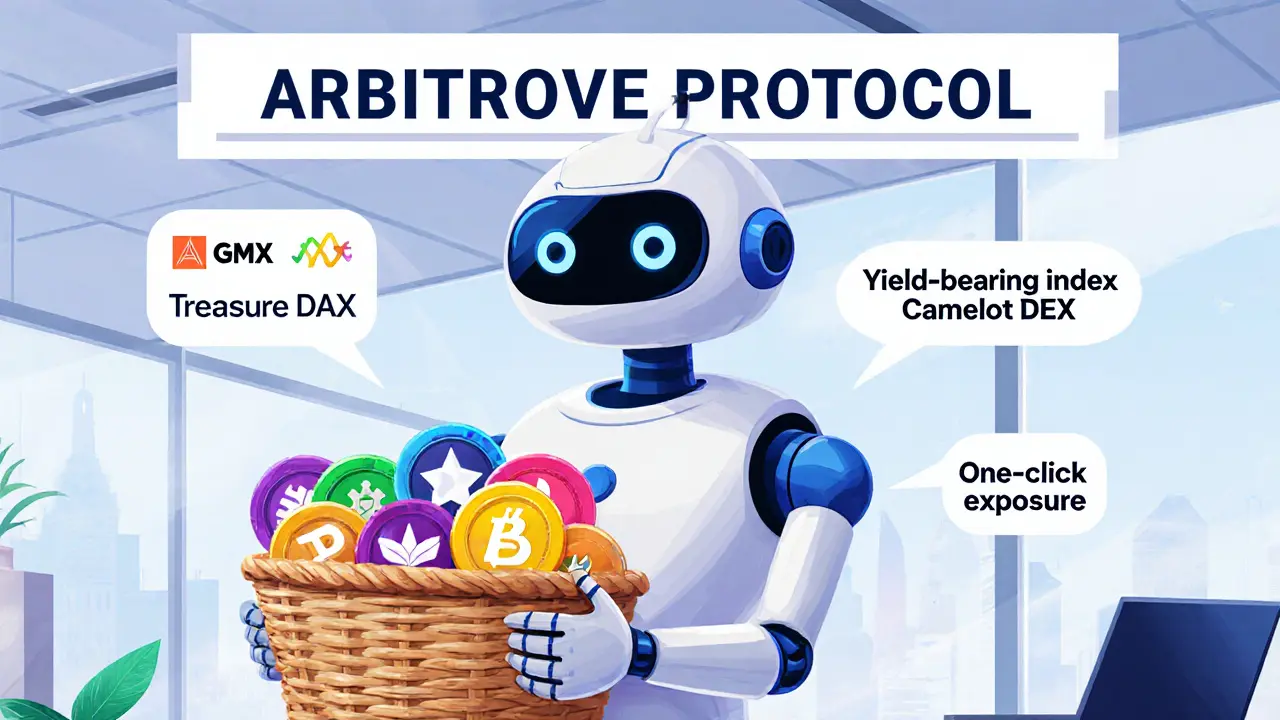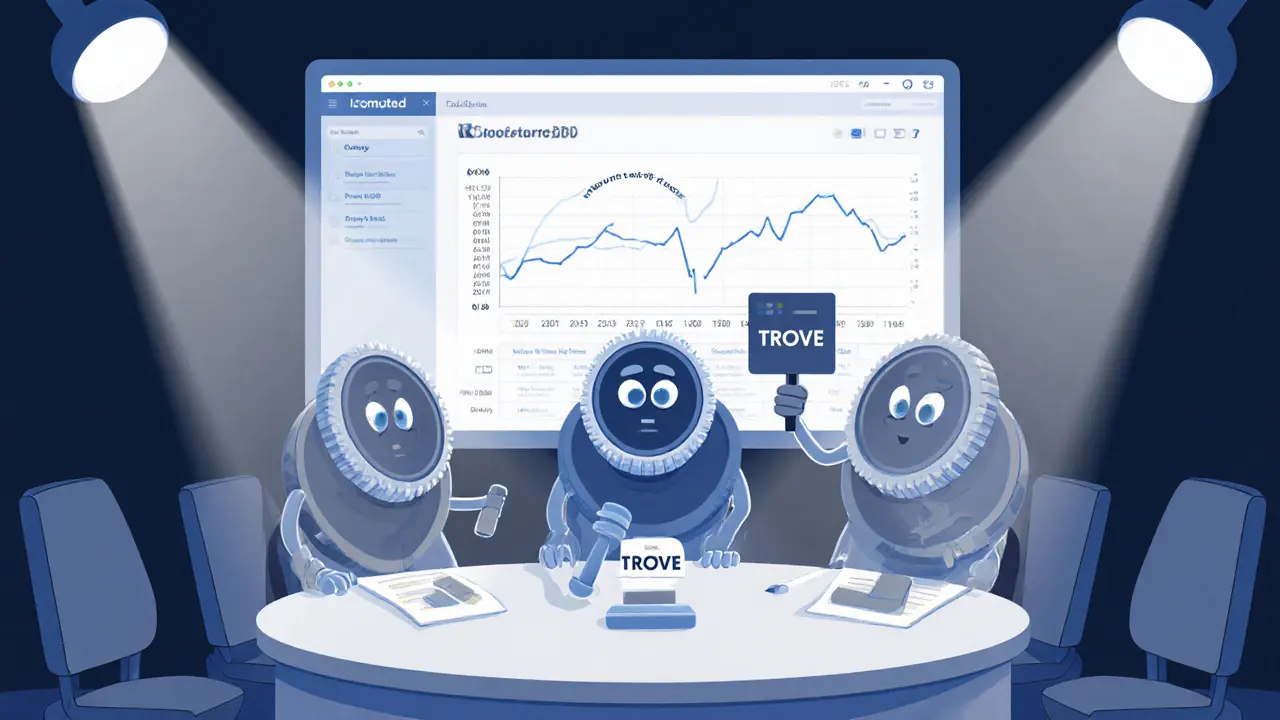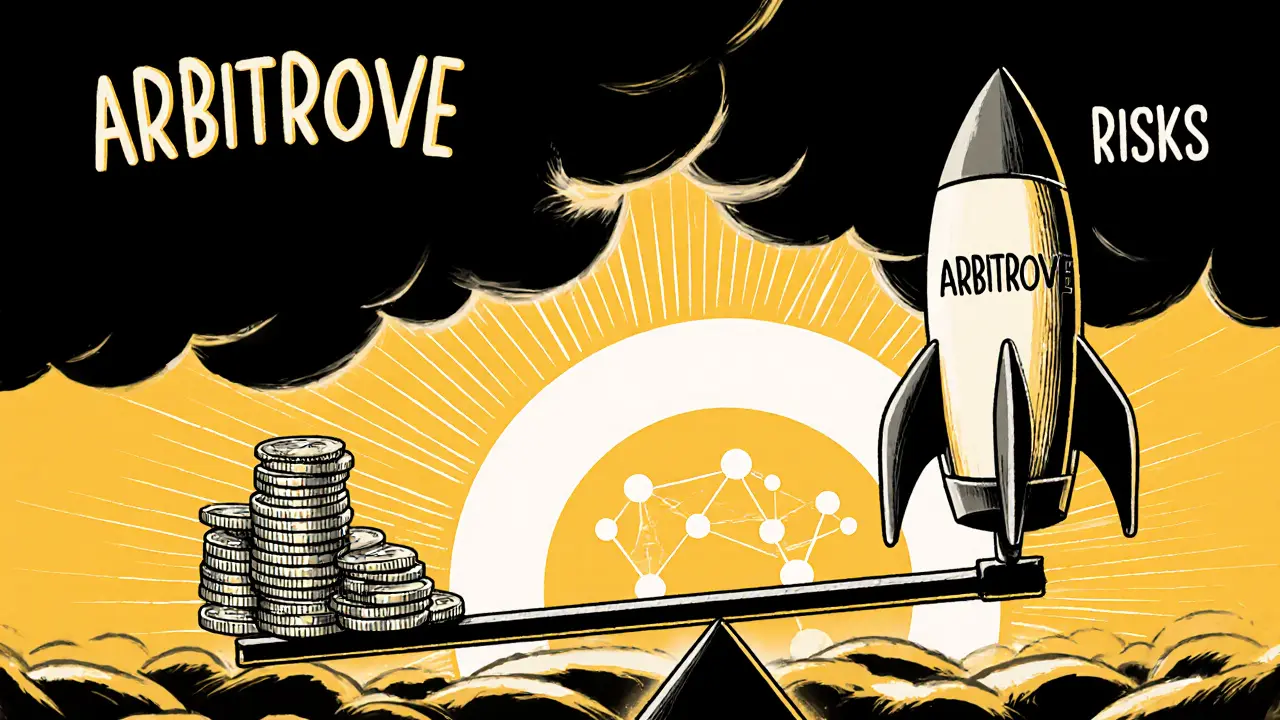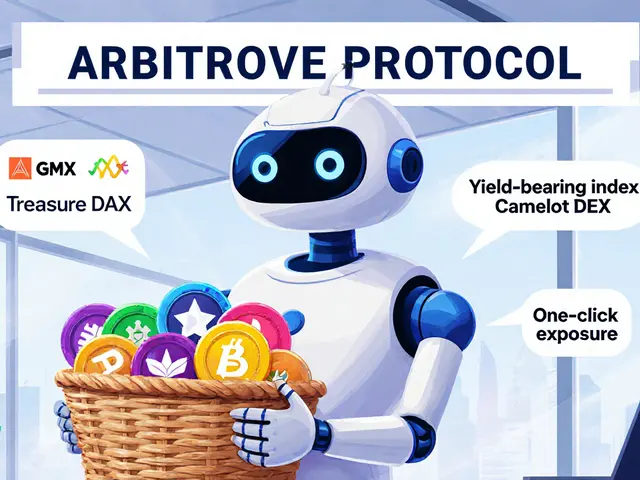Arbitrove Protocol (TROVE) Explained: What It Is and How It Works

TROVE Investment Calculator
Investment Calculator
Estimate your potential returns based on current market data
Current Market Data
Based on October 2023 data
Very high risk due to low liquidity and price depreciation
Results
Enter your TROVE amount to see estimated returns
Arbitrove Protocol is a yield‑bearing index built on the Arbitrum network that lets users expose their capital to a basket of Arbitrum‑native assets. If you’re new to DeFi, the idea sounds simple: combine several tokens into one, let a smart contract rebalance them automatically, and earn the yields those tokens generate. Below we break down exactly what the protocol does, how its governance token TROVE fits in, and whether the project still makes sense in 2025.
What is Arbitrove Protocol?
Arbitrove Protocol is a yield‑bearing index and strategy vault native to the Arbitrum Layer‑2 solution. Launched in February 2023 by the team behind Nitro Cartel, it aims to solve the "too many choices" problem that new users face on Arbitrum. Instead of hunting for individual tokens, investors can buy a single index token that automatically holds a curated mix of blue‑chip DeFi projects, emerging protocols, NFTs, and yield‑farming assets.
Introducing the TROVE governance token
TROVE is the native governance token of Arbitrove Protocol. Holders can vote on protocol upgrades, fee distribution, and which assets get added to the index. In the early months after the Token Generation Event (TGE) on 23 Feb 2023, TROVE was non‑transferable but could be staked for six months. After that period users could either keep staking or begin a one‑year linear vesting schedule.
How the index works: the ALP product
The first product released by the protocol is the ALP (Arbitrum Liquidity Pool) index. ALP is a diversified basket of top‑performing Arbitrum assets such as GMX, Treasure DAO, and Camelot DEX. The smart contract rebalances the basket automatically, swapping tokens to maintain target allocations while harvesting any yield the underlying protocols generate. For a user, that means a single‑click exposure to a multi‑asset strategy without needing to manage each position.
Key players in the basket
- GMX is a decentralized perpetuals exchange on Arbitrum that offers high‑leverage trading.
- Treasure DAO is a community‑run NFT platform and gaming ecosystem on Arbitrum.
- Camelot DEX is a decentralized exchange focused on low‑slippage swaps and liquidity mining.

Tokenomics at a glance
| Metric | Value |
|---|---|
| Total allocation | 530 million TROVE |
| Circulating supply (Oct 2023) | 300 million TROVE |
| Initial IDO price | $0.0673 per TROVE |
| Current price (Oct 2023) | ≈ $0.0015 |
| Market cap (Oct 2023) | ≈ $950 k |
The tokenomics were designed to fund development, reward stakers, and allocate a portion to the Nitro Cartel team. However, the high initial allocation and subsequent price drop have raised concerns about long‑term scarcity.
Market performance and liquidity
Since the IDO, TROVE has lost more than 90 % of its original value. Data from October 2023 shows a price around $0.0015 and a 24‑hour trading volume of only $161, indicating almost no market activity. The token sits near rank #3710 on CoinGecko, with a market cap under $1 million - a tiny slice of the overall crypto market.
How to buy or stake TROVE
For most retail users, the only exchange listing available is Binance, where the token can be bought with USDT or BNB. Because liquidity is scarce, large orders can cause noticeable slippage. After acquiring TROVE, you can stake it directly on the Arbitrove dashboard (accessed via the protocol’s website) to earn a share of the index fees. Remember that staking rewards are only paid out when the underlying ALP index generates yield, which has been modest given the recent market downturn.
Risks and common criticisms
Several red flags appear when you dig into the numbers. First, the token’s price depreciation far outpaces the growth of the underlying assets, suggesting limited demand for the governance token itself. Second, the protocol’s trading volume is so low that price discovery is unreliable - even a small trade can swing the price dramatically. Third, community engagement is minimal; there are few active Reddit threads or Telegram groups, which makes it hard to gauge sentiment or get support.

Why the protocol matters despite the challenges
Even with the current setbacks, Arbitrove Protocol showcases a useful idea: a native index on a Layer‑2 network that reduces gas fees. As Arbitrum’s total value locked grows-over $3.5 billion in Q3 2023-the demand for efficient, multi‑asset products could return. If the team can revive liquidity, improve marketing, and maybe launch a second index product, TROVE’s governance role could become more valuable.
Future outlook and next steps for investors
If you’re considering a position in TROVE, treat it like a high‑risk speculative asset. Watch for any roadmap updates from Nitro Cartel-new product announcements or partnerships could spark interest. Keep an eye on the ALP index’s performance; rising yields might attract more stakers, which in turn could lift TROVE’s price. Lastly, consider diversifying across other Arbitrum‑based projects that have deeper liquidity, such as GMX or Camelot, instead of relying solely on TROVE.
Key takeaways
- Arbitrove Protocol is a yield‑bearing index built on Arbitrum, aiming to simplify exposure to multiple assets.
- TROVE is the governance token; it lets holders vote on protocol changes and earn a slice of fees.
- Tokenomics include 530 M total allocation, 300 M circulating, and an initial IDO price of $0.0673.
- Market price has fallen to roughly $0.0015 with daily volume under $200, indicating very low liquidity.
- Risk factors are high price depreciation, scarce community activity, and limited trading venues.
Bottom line
Arbitrove Protocol offers a clever technical solution, but the market hasn’t rewarded it yet. For a cautious investor, the token’s current state is more of a speculative bet than a solid long‑term hold. Keep monitoring protocol updates and the broader Arbitrum ecosystem before committing significant capital.

Jenna Em
The Arbitrove Protocol feels like a mirror held up to the chaotic crypto jungle.
It promises simplicity, yet beneath the surface there are layers of hidden code.
One wonders who really benefits when a new index appears.
Is it the everyday investor or the shadowy developers pulling strings?
The governance token TROVE claims to give power back, but the price drop tells another story.
When a token loses ninety percent of its value, you have to ask what forces are at play.
Some say it is just market cycles, but I suspect coordinated dumps.
The low liquidity makes the price easy to manipulate, like a puppet on a string.
The protocol’s smart contract automatically rebalances, which sounds fair, yet it could be a backdoor.
If a few whales hold most of the TROVE supply, they can sway decisions.
The tokenomics were written in a way that looks generous but hides scarcity.
The high allocation to the team feels like a safety net for insiders.
In a world where data is scarce, rumors become the only guide.
The community’s silence may be a sign of fear or apathy.
Investing now is a gamble on whether the hidden hands will stay quiet.
Until transparency improves, I remain skeptical of any promises made.
Stephen Rees
Arbitrove seems like a clever idea on paper but there’s a feeling something’s not right underneath.
The token’s collapse hints at forces we don’t see.
Maybe it’s just market sentiment, maybe it’s something else.
Either way, stay cautious.
Katheline Coleman
Dear contributors, I acknowledge the ingenuity behind the ALP index and appreciate the attempt to simplify exposure for users.
Nevertheless, the current liquidity constraints warrant a prudent approach.
Your governance mechanisms could benefit from greater transparency to bolster confidence.
I look forward to constructive dialogue.
Amy Kember
It’s a decent concept but the numbers don’t add up.
Low volume makes price discovery impossible.
Watch the token closely.
Evan Holmes
Looks like another overhyped token to me.
Isabelle Filion
The elegance of the protocol’s design is, of course, undeniable, yet the tokenomics read like a vintage lecture on wealth redistribution for the privileged.
One must applaud the sheer audacity of allocating 530 million tokens while offering a meager market cap that barely scratches a million dollars.
Such disparity inevitably fuels speculation that the token exists primarily as a vehicle for insider profit.
In the grand theatre of DeFi, this performance feels more farce than tragedy.
Therefore, I recommend a judicious skepticism.
Patrick Day
Yo, they don’t want us to see the real game behind TROVE.
All that hype is just a smokescreen for the powers that be.
Keep your eyes open.
Ryan Comers
🔥🔥🔥 This whole thing is a TOTAL SCAM orchestrated by the elite! 🇺🇸💪 We’ll never let them control our crypto! 💥💯
Prerna Sahrawat
In the grand tableau of decentralized finance, Arbitrove emerges not merely as an instrument of yield aggregation, but as a philosophical statement on the very nature of market participation.
One must contemplate the inherent tension between the allure of passive income and the underlying machinations of token governance.
The very architecture of the ALP index, with its auto‑rebalancing visage, masquerades a sophisticated ballet of algorithmic decisions that, when observed through a critical lens, reveal a choreography orchestrated by a select few.
Thus, the ethical quandary is not simply about returns, but about the agency granted to token holders in shaping the future of a nascent ecosystem.
While the surface promises simplicity, the substratum is riddled with complexities that demand earnest academic scrutiny.
Joy Garcia
Yo, this TROVE thing is a glittery mirage, a carnival of colors that dazzles but leaves you empty‑handed.
The way the price nosedives feels like a bad joke written by the universe.
Some folks think it’s just market forces, but I say there’s a shadow puppeteer pulling the strings.
Stay sharp, stay woke.
mike ballard
From a cultural integration standpoint, the Arbitrove protocol showcases an intriguing convergence of cross‑chain liquidity and index‑based diversification.
In practice, the tokenomics exhibit a high‑frequency rebalancing schema that aligns with contemporary DeFi composability standards.
⚙️📊
Tom Glynn
Hey folks, remember that every crypto experiment is a learning curve 😊.
Even if TROVE’s price is low, the experience of staking and governance can build personal resilience.
Keep your heads up! 💪
Anna Kammerer
Well, isn’t this just another perfect illustration of “big promises, tiny execution.”
Congratulations on creating a token that’s practically invisible on the market.
If you need guidance on how to avoid such projects, feel free to ask.
BRIAN NDUNG'U
Esteemed community, the current state of the protocol presents an opportunity for disciplined investors seeking long‑term value creation.
By embracing a patient and methodical approach, one may navigate the present volatility and emerge with a fortified portfolio.
Let us remain steadfast in our convictions.
Donnie Bolena
Hey everyone!; The Arbitrove project sounds intriguing; however; the liquidity issues are concerning; Keep an eye on updates; Stay positive!;